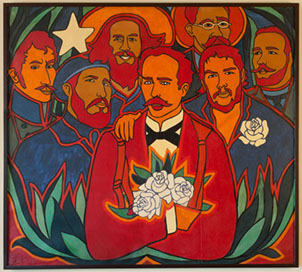
Adios Utopia
A wide-ranging exhibition of post-revolutionary Cuban art is heading to Minneapolis this fall. Adiós Utopia: Dreams and Deceptions in Cuban Art Since 1950 will open at the Walker Art Center in November. The exhibition looks at how Cuba’s revolutionary epoch shaped 65 years of Cuban art through more than a hundred works of painting, graphic design, photography, video, installation and performance by over fifty artists and designers.
The exhibition has been billed by its organizers as the most comprehensive and significant presentation of modern and contemporary Cuban art shown in the United States since 1944, when the Museum of Modern Art in New York presented Modern Cuban Painters. The project was conceived by the Cisneros Fontanals Fundación Para Las Artes (CIFO Europa) and the Miami-based Cisneros Fontanals Arts Foundation, CIFO USA, and was organized in partnership with the Museum of Fine Arts, Houston—where it was first shown-- and the Walker Art Center, Minneapolis.
(CIFO Europa) and the Miami-based Cisneros Fontanals Arts Foundation, CIFO USA, and was organized in partnership with the Museum of Fine Arts, Houston—where it was first shown-- and the Walker Art Center, Minneapolis.
Other hoped-for venues—notably Washington, D.C. and Miami—didn’t end up scheduling the exhibition. Despite the easing of U.S.-Cuban relations, the embargo is still in place. Organizers were unable to secure loans from the National Museum of Fine Arts in Havana, which was reluctant to lend due to fears that art might be confiscated to satisfy American claims to property confiscated in Cuba after Fidel Castro took power. Plus limited large cargo flights meant that many of the works from Cuban collectors and artists had to be routed through Europe.
Organizing Adiós Utopia ultimately became expensive enough that the Smithsonian’s Hirshhorn Museum and Sculpture Garden in Washington, D.C. and the Pérez Art Museum in Miami—declined to participate because of the cost. In an interview, CIFO founder Ella Fontanals-Cisneros opined that “the exhibition was originally planned to be shown at the Hirshhorn, but the museum pulled out. I think some institutions are fearful of political implications.”
Despite the organizational difficulties and expenses, Adiós Utopia is a long overdue presentation of artists who remained in Cuba or whose careers took off after the 1959 revolution. The exhibition views their work—as its title suggests-- through the lens of utopia, both its promise and its failure.
Instead of providing audiences with a historic narrative, the exhibition aims to start a visual and conceptual dialogue about modern and contemporary art in Cuba within a local and global context. Adiós Utopia focuses on the artistic experience on the island, as Cuba’s artists have wrestled with the hopes, realities and contradictions of a purported social and political utopia.
The curators have organized the exhibition in six thematic sections. It opens with an introduction to Cuba’s “Concrete” art movement of the 1950s, whose artists sought to create avant-garde art, abandoning representational art in favor of abstract line, color and form. The second section--Cult and Destruction of the Revolutionary Nation-- traces the development of Cuba’s revolutionary icons—including the Cuban flag, national leaders and rebel soldiers—from their origin in the 1960s to their various re-interpretations throughout the decades. Next comes a section devoted to Poster Art, one of the strongest visual elements of the Cuban Revolution. The posters promoted political ideals, but also showcased innovations in graphic design and political messaging.
The works in Imposition of Words: Discourse, Rhetoric and Media Controls focus on the role of speech and discourse in shaping revolutionary ideology, as well as themes of censorship and media controls. The waters surrounding Cuba have acted as both a gateway to the rest of the world and as a barrier to insulate the country. A section of the exhibition entitled Sea, Borders, Exile focuses on territorial tensions—specifically between Cuba and the United States—and mass migrations as represented by the sea. Many of the works included relate to humanitarian crises in the 1990s. Lost Illusions and Inverted Utopia shows how the Cuban Revolution sought to create a utopian social order, but also that its reality was often characterized by paradox, strife and disillusionment. This final section of Adiós Utopia presents works created over the past 40 years that chart the unraveling of the utopian dream.
One reviewer summed up the exhibition this way:“Discredited for many as a utopia, Cuba is hot as a destination now, and as a source of art… Adiós Utopia will win plenty of friends for these intrepid Cuban artists, but not many for the Cuban government.”
Adiós Utopia: Dreams and Deceptions in Cuban Art Since 1950 will be on display at the Walker Art Center, Minneapolis, Minnesota November 11, 2017 through March 18, 2018.
John Coppola